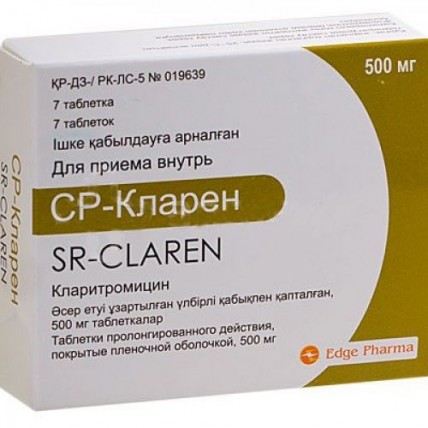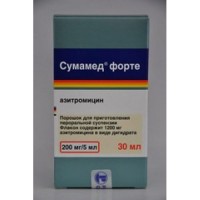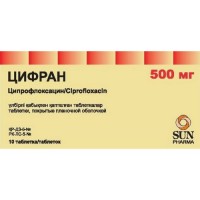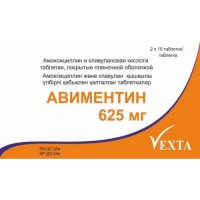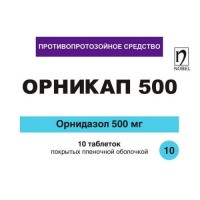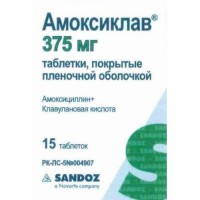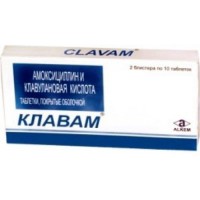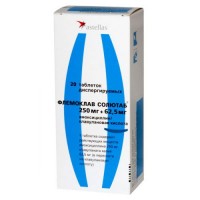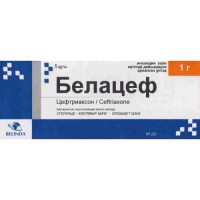CP Clarene 500 mg film-coated (7 tablets)
- $20.40
The instruction for medical use of SR-Klaren Torgovoye medicine name SR-Klaren the International unlicensed name Klaritromitsin Lekarstvennaya a form of the Tablet of the prolonged action, film coated, 500 mg Structure One tablet contains active agent: klaritromitsin - 500 mg, excipients: lactose, hydroksipropilmetiltsellyuloza (Metotsel K-100 LVP), talc, magnesium stearate, cover: Vinknut WT - 01533 (yellow) on one tablet: hydroksipropilmetiltsellyuloza, macrogoal 400, titan dioxide, talc, macrogoal 6000, aluminum varnish quinolinic yellow. Description of the Tablet of a capsulovidny form, film coated yellow color. Pharmacotherapeutic group Antibacterial drugs for system use. Macroleads, linkozamida and streptogramina. Macroleads. Klaritromitsin. ATX J01FA09 code the Pharmacological Pharmacokinetics Absorption properties of a klaritromitsin from tablets of the prolonged action - it is slowed down, but is equivalent to absorption from tablets of immediate action in equal doses. Time of achievement of the maximum concentration increases, at a concomitant use of a daily dose of 500 mg, this time is about 7.5 hours for a klaritromitsin and 7.7 hours for its metabolite of a 14-hydroksiklaritromitsin. The maximum concentration at reception of tablets of the prolonged action somewhat is lower in comparison with tablets of immediate action. Equilibrium concentration is reached by 3rd day. The bioavailability of tablets with the prolonged action is 30% lower, at reception on an empty stomach therefore patients have to take the prolonged form of a klaritromitsin at meal time. Concentration of a klaritromitsin in body tissues in 10 times more than in plasma. High concentrations are found in lungs (8.8 mg/kg), in tonsils (1.6 mg/kg), in a mucous membrane of a nose, in integuments, in saliva, in alveolar cells, in a phlegm and in a tympanic cavity. Linking of a klaritromitsin with proteins of blood plasma insignificant and reversible. Klaritromitsin is metabolized in a liver with formation, at least, of 7 metabolites. The most basic of which is 14-hydroksiklaritromitsin. Elimination half-life after single reception of a daily dose of 500 mg makes 5.5 hours for a klaritromitsin and 9.3 hours for a 14-hydroksiklaritromitsin. About 40% of a klaritromitsin are removed with urine and more than 30% with excrements. Patients of advanced age Data show that correction of a dose is not required to patients of advanced age, except for cases when their function of kidneys is seriously broken. Patients with a renal failure After intake of 200 mg of a klaritromitsin the increase in the maximum concentration and AUC and decrease in removal of a klaritromitsin at patients with a heavy renal failure in comparison with healthy was observed. These results show that the dose decline is necessary at patients with a heavy renal failure. Thus, tablets of the prolonged action are not suitable for patients at whom the clearance of creatinine (CC) is less than 0.5 ml / with (30 ml/min.). These patients should appoint the corrected dose of a tablet of a klaritromitsin with immediate action. Pharmacodynamics SR-Klaren - a semi-synthetic antibiotic of group of macroleads. Breaks synthesis of protein of microorganisms (contacts 50S a subunit of a membrane of ribosomes of a microbic cell). Works on out of - and intracellularly located activators. The activity of a klaritromitsin concerning the majority of strains of the following microorganisms is proved as in vivo, and in clinical practice - aerobic gram-positive microorganisms: Staphylococcus aureus, Streptococcus pneumoniae, Streptococcus pyogenes, aerobic gram-negative microorganisms: Haemophilus influenzae, Haemophilus parainfluenzae, Moraxella catarrhalis, Legionella pneumophila, other microorganisms - Mycoplasma pneumoniae, Chlamidia pneumoniae, mycobacteria: Mycobacterium avium complex (MAC) - the complex including: Mycobacterium avium and Mycobacterium intracellulare, Helicobacter pylori. Beta laktamazy do not affect activity of a klaritromitsin. Activity of a klaritromitsin of in vitro - aerobic gram-positive microorganisms: Listeria monocytogenes, Streptococcus agalactiae, Streptococci group of C, F, G, viridans group Streptococci, aerobic gram-negative microorganisms: Neisseria gonorrhoeae, Bordetella pertussis, Pasteurella multocida, anaerobic gram-positive microorganisms: Clostridium perfringens, Peptococcus niger, Propionibacterium acnes, anaerobic gram-negative microorganisms: Bacteroides melaninogenicus, spirochetes: Borrelia burgdorferi, Treponema pallidum, mycobacteria: Mycobacterium leprae, Mycobacterium chelonae, campylobacters: Campylobacter jejuni. Microbiological active metabolite of a klaritromitsin - 14(R) - hydroksiklaritromitsin, is twice more active, than initial connection in relation to Haemophilus influenzae. Klaritromitsin and his metabolite in a combination can render both additive, and synergy action on Haemophilus influenzae in vitro and in vivo, depending on a strain of a bacterium. The majority of strains of the stafilokokk resistant to Methicillinum and Oxacillinum, rezistentna to a klaritromitsin. Development of cross resistance to a klaritromitsin and other antibiotics of group of macroleads and also lincomycin and clindamycin is possible. Indications - infections of lower parts of airways (bronchitis, pneumonia, etc.) - infections of upper parts of airways (pharyngitis, sinusitis, etc.) - infections of skin and soft tissues (a folliculitis, erizipeloid, etc.). A route of administration and doses the Recommended dose SR-Klaren for adults makes 500 mg at meal time once a day. In heavier infections it is possible to increase a dose to 1000 mg once a day (2 tablets on 500 mg). The usual duration of treatment is from 5 to 14 days, except for treatment of community-acquired pneumonia and sinusitis which demand 7-14 days of therapy. It is necessary to swallow of tablets whole, without chewing. In a renal failure of the tablet SR-Klaren it is not necessary to appoint if KK less than 0.5 ml / with (30 ml/min.). Side effects by the Most frequent and general side reactions at treatment klaritromitsiny adults and children are an abdominal pain, diarrhea, nausea, vomiting and distortion of taste. These side reactions usually softly expressed are also coordinated with the known profile of safety of makrolidny antibiotics. Side reactions are distributed on emergence frequency: very frequent ≥ 1/10, frequent ≥1/100, infrequent ≥1/1000, it is rare ≤ 1/10000 and is very rare ≤ 1/100000. Very often - phlebitis in the injection site it is frequent - insomnia - a headache - a dizgevziya (disturbance of flavoring sensitivity), distortion of taste - a vazodilatation - nausea, an abdominal pain, vomiting, dyspepsia, diarrhea - an aberration of functional tests of a liver - rash, a hyperhidrosis Infrequently - cellulitis, a candidiasis, a gastroenteritis - an infection, vaginal infections - a leukopenia, neytropeniya4, trombotsitemiya3, eozinofiliya4 - anaphylactoid reaktsii1, hypersensitivity - anorexia, a loss of appetite - uneasiness, nervoznost3 - loss soznaniya1, diskineziya1, dizziness, drowsiness, a tremor - vertigo, deterioration in hearing, a ring in ears - a stop serdtsa1, fibrillation predserdiy1, lengthening of an interval of QT on the ECG, ekstrasistoliya1, a cardiopalmus - astma1, nasal krovotecheniye2, a vascular embolism legkikh1 - ezofagit1, gastroesophageal reflux bolezn2, gastritis, proktalgiya2, stomatitis, a glossitis, swelling zhivota4, a constipation, dryness in a mouth, an eructation, a meteorism - holestaz4, gepatit4, increase in the ALT, nuclear Heating Plant level, GGTP4 - violent dermatit1, an itching, urticaria, makulo-papular syp3 - muscular spazmy3, skeletal and muscular rigidnost1, mialgiya2 - increase in creatinine krovi1, increase in urea krovi1 - nedomoganiye4, likhoradka3, an asthenia, pain in grudi4, oznob4, raised utomlyaemost4 - change of a ratio albumine-globulin1, increase in level of alkaline phosphatase in serum krovi4, increase in level of a lactate dehydrogenase in serum krovi4 Single messages 1,2,3,4 was reported About these side reactions only at drug use in shape: 1 – powder of the solution lyophilized for preparation for infusions, 2 – tablets of the prolonged action, 3 – suspensions, 4 – tablets of immediate release. Post-marketing messages (at practical application of a klaritromitsin) Frequency is unknown as about these reactions it was reported voluntarily from unspecified population of patients. Not always it is possible to establish precisely their frequency or a causal relationship with administration of drug. - pseudomembranous colitis, erizipeloid - an agranulocytosis, thrombocytopenia - anaphylactic reaction, a Quincke's edema - psychoses, confusion of consciousness, depersonalization, a depression, a disorientation, hallucinations, dreadful dreams, a mania - muscular spasms, an ageusia (loss of flavoring sensitivity), a parosmiya, an anosmia, paresthesia - a hearing loss - piruetny ventricular tachycardia (torsades de pointes), ventricular tachycardia - hemorrhage - acute pancreatitis, discoloration of language, discoloration of teeth - a liver failure, hepatocellular jaundice - Stephens-Johnson's syndrome, a toxic epidermal necrolysis, medicamentous skin reaction which is followed by an eosinophilia and system manifestations (DRESS), an acne - rabdomioliz2 (in some messages about developing of a rhabdomyolysis klaritromitsin applied at the same time with other medicines which are connected with development of a rhabdomyolysis (such as statines, fibrata, colchicine or Allopyrinolum)), a myopathy - a renal failure, interstitial nephrite - increase in the international normalized ratio, increase in a prothrombin time, urine discoloration. Patients with disturbance of the immune system. At patients with AIDS and other patients with disturbance of the immune system applying high doses of a klaritromitsin longer than it is recommended for treatment of mikobakterialny infections, it is not always possible to distinguish the side reactions connected with drug use and symptoms of the basic or associated diseases. Adult patients who received SR-Klaren in a daily dose 1000 mg the most frequent side effects had a nausea, vomiting, disturbance of taste, an abdominal pain, diarrhea, rash, an abdominal distension, a headache, a constipation, a hearing disorder, increase in maintenance of ALT and nuclear heating plant. Not often there were dispnoe, insomnia and dryness in a mouth. At 2–3% of patients the substantial increase of the ALT and nuclear Heating Plant levels and considerable decrease in quantity of leukocytes and thrombocytes in blood was observed. At several patients the increase in content of urea in blood was observed. Contraindications hypersensitivity to makrolidny antibiotics or other components of drug simultaneous use of a klaritromitsin and any of the following drugs: astemizol, tsizaprid, Pimozidum, terfenadin (as it can lead to lengthening of an interval of QT and development of cardiac arrhythmias, including ventricular tachycardia, fibrillation of ventricles and piruetny ventricular tachycardia (torsade de pointes), ergotamine or dihydroergotamine (as it can lead to an ergotoksichnost) midazolam for oral administration inhibitors of GMG-KoA-reduktazy (statinina) which are widely metabolized by CYP3A4 (lovastatin or simvastatin), because of risk of developing of a rhabdomyolysis (see the section "Medicinal Interactions" and "Special Instructions") ticagrelor or ranolazin the patients who had in the anamnesis lengthening of an interval QT or ventricular cardiac arrhythmias including piruetny ventricular tachycardia (torsade de pointes) simultaneous use of colchicine and the R-glycoprotein or strong CYP3A4 inhibitor (for example, a klaritromitsina) to patients with a renal or liver failure - patients with KK less than 30 ml/min. (as this form of drug does not allow to lower a dose lower than 500 mg a day) - a hypopotassemia (risk of increase in an interval of QT) the lactation period children's age up to 18 years - a lactose intolerance, deficiency of lactase, glyukozo-galaktozny malabsorption With care a renal and/or liver failure, gravis myasthenia, a concomitant use of the medicines which are metabolized a liver. Medicinal interactions Combined use of the following medicines with SR-Klaren is strictly contraindicated as their combination can cause serious consequences of interaction: Tsizaprid, Pimozidum, astemizol and terfenadin At the patients who were at the same time applying klaritromitsin and tsisaprid the increase in level of a tsizaprid was noted. It can lead to increase in an interval of QT and cardiac arrhythmia, including ventricular tachycardia, fibrillation of ventricles and bidirectional tachycardia. The similar phenomena were recorded at the patients who were at the same time applying klaritromitsin and Pimozidum. There are data on change of metabolism of a terfenadin at reception of macroleads that in some cases causes cardiac arrhythmia with increase in an interval of QT, tachycardia of ventricles, fibrillation of ventricles and bidirectional tachycardia. Ergot alkaloids Postmarketingovy researches show that joint reception of a klaritromitsin and ergotamine or dihydroergotamine can lead to the toxic action of an ergot which is shown in the form of an angiospasm, ischemia of extremities and other fabrics including the central nervous system. Inhibitors of GMG-KoA-reduktazy (statines) It is necessary to appoint with care combined use SR-Klaren with statines. Joint reception SR-Klaren with lovastatiny or simvastatiny is contraindicated as these statines are substantially metabolized by CYP3A4, and existence of a klaritromitsin causes increase in their concentration in plasma because of what risk of development of a myopathy and a rhabdomyolysis increases. The patients who were at the same time accepting klaritromitsin with these statines have data on cases of developing of a rhabdomyolysis. If use SR-Klaren is obligatory, then reception of a lovastatin or simvastatin is stopped for the period of use SR-Klaren. If simultaneous use SR-Klaren and statines inevitably, it is necessary to consider the possibility of prescribing of statine which does not depend on metabolism of CYP3A, for example, of a fluvastatin. It is recommended to write out minimum possible dose of statine. At patients it is necessary to keep track of signs and symptoms of a myopathy. Influence of other medicines on therapeutic effectiveness SR-Klaren the Drugs inducing CYP3A (for example, rifampicin, Phenytoinum, carbamazepine, phenobarbital, a St. John's wort) can accelerate metabolism of a klaritromitsin. It can lead to decrease in therapeutic concentration of a klaritromitsin that will lead to decrease in efficiency of the drug SR-Klaren. Besides, tracking levels of other medicines which raise CYP3A can be required, they can raise owing to inhibiting effect of a klaritromitsin on CYP3A (see also instruction for medical use of the corresponding CYP3A4 inhibitor). It is known that the concomitant use of a rifabutin and a klaritromitsin leads to increase in level of a rifabutin and decrease in level of a klaritromitsin in serum and also increase in risk of a uveitis. It is known that the following drugs either cause, or can theoretically cause change of the circulating concentration of a klaritromitsin. Correction of a dose of the drug SR-Klaren can be required. Also it is necessary to consider other options of treatment. Efavirents, not Virapinum, rifampicin, rifabutin and rifapentine Strong inductors of a metabolic system of P450 cytochrome, such as efavirents, not Virapinum, rifampicin, rifabutin and rifapentine can accelerate metabolism of a klaritromitsin, thus, reducing its level in plasma with simultaneous increase in levels 14(R) - a hydroksiklaritromitsina (14-OH-klaritromitsina) - a metabolite which also shows microbiological activity. As microbiological influence of a klaritromitsin and 14-OH-klaritromitsina on various bacteria differs, joint reception of a klaritromitsin with inductors of enzymes can interfere with desirable therapeutic effect. Etravirin Pri reception of an etravirin, exposure of a klaritromitsin decreases, and concentration of its active metabolite - 14-OH-klaritromitsina - increases. As 14-OH-klaritromitsin is less effective remedy against a mikobakterialny complex (MAC), the overall effectiveness of drug concerning this pathogen can change. For this reason, for treatment MAC should consider alternative var
Anta treatments. Flukonazol Equilibrium concentration of an active metabolite 14-ON-klaritromitsina considerably did not change at combined use with flukonazoly. Dose adjustment SR-Klarena is not required. Ritonavir Issledovaniye of pharmacokinetics showed that the concomitant use of 200 mg of a ritonavir each eight hours and the drug SR-Klaren each 12 hours, leads to noticeable inhibition of metabolism of a klaritromitsin. Pri joint reception with ritonaviry, Cmax of a klaritromitsin increased by 31%, Cmin decreased by 182%, AUC increased by 77%. Almost complete inhibition of education 14-OH-klaritromitsina was noted. Because of wide therapeutic range the reduction of a dose of the drug SR-Klaren with normal function of kidneys is not required from patients. At patients with a renal failure the dose adjustment is necessary: at CLCR of 30-60 ml/min. the dose of the drug SR-Klaren needs to be lowered by 50%, at CLCR & lt, 30 ml/min. – for 75%. The drug SR-Klaren doses exceeding 1 g/day should not be applied together with ritonaviry. Similar corrections of a dose should be carried out at patients with a renal failure at use of a ritonavir as the pharmacokinetic amplifier together with other inhibitors of HIV protease, including atazanavir and sakvinavir. Influence SR-Klaren on other medicines Antiarrhytmic drugs according to post-marketing reports, cases of developing of bidirectional tachycardia at a concomitant use of a klaritromitsin with quinidine or Disopyramidum are recorded. Pri concomitant use SR-Klaren with these drugs is recommended to carry out ECG monitoring for early detection of lengthening of an interval of QT. During therapy by the drug SR-Klaren it is necessary to watch concentration of these drugs in blood serum. Also in post-marketing reports hypoglycemia cases at a concomitant use of a klaritromitsin and Disopyramidum are recorded. Pri a concomitant use of the drug SR-Klaren and Disopyramidum should trace glucose level in blood. Oral hypoglycemic means and insulin Separate hypoglycemic drugs, such as nateglinid and repaglinid, can cause inhibition klaritromitsiny CYP3A enzyme because of what at their concomitant use the hypoglycemia can develop. Careful observation of glucose level at patients with diabetes at use SR-Klaren is recommended. Interaction with CYP3A Combined use of a klaritromitsin known as CYP3A enzyme inhibitor, and any other drug, generally metabolized CYP3A, can lead to increase in concentration of the last in blood plasma that, in turn, can strengthen or prolong its therapeutic effect and risk of emergence of side reactions. It is necessary to be careful at use SR-Klaren for the patients receiving therapy by medicines – CYP3A substrates, especially if CYP3A substrate has narrow therapeutic range (for example, carbamazepine) and/or is extensively metabolized by this enzyme. Change of a dose and monitoring of serumal concentration of medicine, the metabolized CYP3A at patients who at the same time apply SR-Klaren can be necessary. It is known that the following medicines or groups of drugs are metabolized by the same CYP3A an isoenzyme: to alprazola, astemizol, carbamazepine, tsilostazol, tsizaprid, cyclosporine, Disopyramidum, alkaloids of horns, lovastatin, Methylprednisolonum, midazolam, omeprazolum, oral anticoagulants (for example, warfarin), Pimozidum, quinidine, rifabutin, sildenafit, simvastatin, takrolimus, terfenadin, to triazoles and vinblastine, but this list not full. The similar mechanism of interaction is noted at use of Phenytoinum, theophylline and Valproatum which are metabolized by other isoenzyme of a system of P450 cytochrome. Omeprazolum there Are results of a research on adult healthy volunteers who took at the same time oral form of a klaritromitsin (to 500 mg there are each 8 hours) and omeprazolum (40 mg daily). At reception along with klaritromitsiny increase in equilibrium concentration of omeprazolum in plasma was noted (increase in Cmax, AUC0-24 and t1/2 by 30%, 89% and 34%, respectively). The average value of an indicator pH in a stomach was 5.2 at intake of omeprazolum separately and 5.7 at intake of omeprazolum together with klaritromitsiny. Sildenafil, tadalafit and vardenafit there Is a probability of increase in plasma concentration of inhibitors of phosphodiesterase (the sildenafila, tadalafit and vardenafit) at their combined use with klaritromitsiny that can demand reduction of a dose of inhibitors of phosphodiesterase. Theophylline, carbamazepine Results of clinical trials show that there is a small, but significant (p≤0.05) increase in the circulating concentration of theophylline and carbamazepine at joint reception with klaritromitsiny. Tolterodin Tolterodin, mainly, is metabolized by a 2D6-isoform of P450 (CYP2D6) cytochrome. However at patients without CYP2D6 the metabolism happens through CYP3A. In this population the oppression of CYP3A leads to substantial increase of plasma concentration of a tolterodin. For such patients the lowering of a dose of a tolterodin can be necessary at its use with CYP3A inhibitors, such as SR-Klaren. Triazolobenzodiazepines (for example, to alprazola, midazolam, to triazoles) Joint intake of midazolam orally and a klaritromitsina is contraindicated. At intravenous use of midazolam with klaritromitsiny it is necessary to carry out careful monitoring of a condition of the patient for timely dose adjustment. It is necessary to observe the same precautionary measures at use of other benzodiazepines which are metabolized by CYP3A, including triazoles and alprazola. For benzodiazepines which elimination does not depend on CYP3A (temazepam, nitrazepam, lorazepam) the development of clinically significant interaction with klaritromitsiny is improbable. There are post-marketing messages about medicinal interaction and development of by-effects from the central nervous system (such as drowsiness and confusion of consciousness) at combined use of a klaritromitsin and triazolam. It is necessary to watch the patient, considering a possibility of increase in pharmacological effects from central nervous system. Interaction with other medicines Aminoglycosides It is necessary to appoint with care joint reception of a klaritromitsin and other ototoksichny drugs, especially aminoglycosides. Colchicine is substrate both for CYP3A, and for the effluxny carrier of a p-glycoprotein. It is known that klaritromitsin and other macroleads are CYP3A inhibitors and a p-glycoprotein. In case of simultaneous use SR-Klarena and colchicine, the inhibition klaritromitsiny a p-glycoprotein and CYP3A can lead to increase in exposure of colchicine. At patients it is necessary to monitor clinical manifestations of intoxication colchicine. Patients with normal function of a liver and kidneys need to lower a colchicine dose at a concomitant use with the drug SR-Klaren. Joint reception SR-Klaren and colchicine is contraindicated to patients with a liver and renal failure. Digoxin is considered substrate of a P-glycoprotein (Pgp). It is known that klaritromitsin Pgp is capable to oppress. At simultaneous use, oppression of Pgp can lead to increase in exposure of digoxin. At post-marketing observation the increase in concentration of digoxin in blood serum of the patients receiving klaritromitsin together with digoxin was revealed. At some patients signs of digitalis toxicity, including potentially fatal arrhythmias developed. It is necessary to control carefully concentration of digoxin in blood serum of patients at its use with klaritromitsiny. The zidovudine and a zidovudine by adult HIV-positive patients can lead Concomitant oral administration of a klaritromitsin in tablets to decrease in equilibrium concentration of a zidovudine. Klaritromitsin makes impact on absorption of a zidovudine at their concomitant use orally, it in essential degree can be avoided by observance of a 4-hour interval between receptions of a klaritromitsin and a zidovudine. This interaction does not arise at the patients children infected with HIV at intake of suspension of a klaritromitsin along with a zidovudine and dideoxyinosine. Probability of similar interaction at intravenous administration SR-Klaren is extremely small. Phenytoinum and Valproatum by results of the spontaneous and published reports is noted interaction between CYP3A inhibitors, such as klaritromitsin, and drugs in which metabolism CYP3A theoretically does not participate (for example, Phenytoinum and Valproatum). At joint prescribing of such drugs with SR-Klaren it is recommended to carry out the analysis of their level in serum. There are data on increase in concentration of these drugs in serum. Bidirectional interaction with Atazanavir Klaritromitsin medicines and atazanavir are substrates and CYP3A inhibitors. There is a confirmation of bidirectional interaction between these drugs. And the atazanavira (400 mg once a day) leads combined use of a klaritromitsin (500 mg twice a day) to increase in exposure of a klaritromitsin twice, to decrease in exposure 14-OH-klaritromitsina for 70%, and to increase in AUC of an atazanavir by 28%. As klaritromitsin it is characterized by a considerable therapeutic window, the dose decline of a klaritromitsin with normal function of kidneys is not required from patients. For patients with an average renal failure (KK from 30 to 60 ml/min.) the dose of the drug SR-Klaren has to be reduced by 50%. For patients with KK less than 30 ml/min. dose SR-Klaren has to be reduced by 75% by use of the corresponding dosage form. At joint reception with protease inhibitors dose SR-Klaren should not exceed 1000 mg a day. Blockers of calcium channels Because of risk of developing arterial hypotension should be applied with care klaritromitsin along with blockers of calcium channels, the metabolized CYP3A4 (for example, verapamil, amlodipin, diltiazem). In interaction plasma concentration both a klaritromitsina, and blockers of calcium channels can increase. At the patients receiving klaritromitsin together with verapamil the arterial hypotension, bradyarrhythmia and lactoacidosis were observed. Itrakonazol Klaritromitsin and itrakonazol are substrates and CYP3A inhibitors in this connection, klaritromitsin can increase plasma levels of an itrakonazol and vice versa. At use of an itrakonazol together with the drug SR-Klaren the patients have to be under fixed observation of the doctor for identification of manifestations and symptoms of the enhanced or prolonged pharmacological effect. Sakvinavir Klaritromitsin and sakvinavir are substrates and CYP3A inhibitors. There is a confirmation of bidirectional interaction between these drugs. The research on 12 healthy volunteers showed that a concomitant use of a klaritromitsin (500 mg twice a day) and the sakvinavira (in soft gelatin capsules on 1200 mg three times a day) causes increase in equilibrium indicators of a sakvinavir of AUC and Cmax by 177% and 187% in comparison with reception of a sakvinavir separately. Indicators of a klaritromitsin of AUC and Cmax increased approximately by 40% in comparison with reception of a klaritromitsin separately. Results of a research showed that in case of use of the studied dosages and dosage forms, dose adjustment is not required. Results of a research of a dosage form in the form of soft gelatin capsules can not correspond to indicators of a sakvinavir in solid gelatin capsules. Results of a research of interaction with sakvinaviry can not correspond to indicators when passing combination therapy sakvinaviry and ritonaviry. If sakvinavir it is appointed along with ritonaviry, it is necessary to consider potential impact of a ritonavir on klaritromitsin. Special instructions Prolonged or repeated use of an antibiotic can cause the excess growth of insensitive bacteria and mushrooms. At emergence of superinfection it is necessary to stop use SR-Klaren and to begin the corresponding therapy. With care it is necessary to use drug at patients with a renal failure easy and moderate severity. At reception of a klaritromitsin, cases of developing of dysfunction of a liver, including increase in level of liver enzymes and hepatocellular or cholestatic hepatitis, with jaundice or without it are recorded. Similar dysfunction of a liver can be heavy and usually is reversible. Also cases of a liver failure from the death which were connected with serious associated diseases or intake of the accompanying medicines were recorded. At emergence of symptoms of hepatitis, such as anorexia, jaundice, dark urine, itching or painful stomach, it is necessary to stop use SR-Klaren immediately. The most part of a klaritromitsin is removed through a liver. Therefore patients with disturbance of functions of a liver need to appoint this antibiotic with care. At reception of the majority of antibacterial drugs, including macroleads, cases of pseudomembranous colitis which degree varies from average to life-threatening were recorded. At reception of the majority of antibacterial drugs, including klaritromitsin, cases of the diarrhea associated with Clostridium difficile (CDAD) which degree varies from average to lethal colitis were recorded. Intake of antibacterial drugs changes normal flora of intestines that leads to the increased growth of C.difficile. It is necessary to consider possibility of CDAD at all patients who suffer from the diarrhea caused by reception of antibiotics. It is necessary to make the careful medical anamnesis as cases of emergence of CDAD later after intake of antibacterial drugs were recorded two months. Colchicine In post-marketing reports is reported about toxicity of colchicine at joint reception with klaritromitsiny, especially at patients of old age some of which had a renal failure. At some patients cases of a lethal outcome were recorded. Joint administration of drug SR-Klaren and colchicine is contraindicated. It is necessary to appoint with care SR-Klaren along with triazolobenzodiazepines, such as to triazoles and midazolam intravenously. It is necessary to appoint with care combined use SR-Klaren and other ototoksichny drugs, especially aminoglycosides. In time and after treatment it is necessary to observe vestibular and acoustical functions. Because of risk of increase in an interval of QT it is necessary to use SR-Klaren with care at patients with coronary heart disease, heavy heart failure, a hypomagnesiemia, bradycardia (& lt, 50 beats per minute) or at a concomitant use with other medications which can cause increase in QT. Use of a klaritromitsin by patients with the congenital or acquired by increase in an interval QT or ventricular arrhythmia in the anamnesis is forbidden. Pneumonia As is possible resistance of Streptococcus pneumoniae to macroleads, it is important to carry out the sensitivity test when assigning a klaritromitsin for treatment of not hospital pneumonia. In case of hospital pneumonia SR-Klaren it is necessary to apply in a combination with other corresponding antibiotics. Infections of skin and soft tissues insignificant and moderately severe the Most frequent causative agents of similar infections are Staphylococcus aureus and Streptococcus pyogenes which can also be resistant to macroleads. Therefore, it is necessary to conduct a research on susceptibility. In cases if use beta laktamnykh antibiotics is impossible (for example, because of an allergy), other drugs, for example, clindamycin are the most preferable. Now, macroleads are used only for treatment of separate types of infectious damage of skin and soft tissues, for example, of the diseases caused by Corynebacterium minutissimum, eels ordinary and a creeping erythema and also in situations when treatment by penicillin is impossible. If serious acute hyper sensitive reactions, such as anaphylaxis, Stephens-Johnson's syndrome, toksikodermalny necrolysis or the medicinal skin reaction which is followed by an eosinophilia and system manifestations are observed, use SR-Klaren should be stopped immediately and to urgently render the corresponding treatment. SR-Klaren it is necessary to appoint with care tog
Anta treatments. Flukonazol Equilibrium concentration of an active metabolite 14-ON-klaritromitsina considerably did not change at combined use with flukonazoly. Dose adjustment SR-Klarena is not required. Ritonavir Issledovaniye of pharmacokinetics showed that the concomitant use of 200 mg of a ritonavir each eight hours and the drug SR-Klaren each 12 hours, leads to noticeable inhibition of metabolism of a klaritromitsin. Pri joint reception with ritonaviry, Cmax of a klaritromitsin increased by 31%, Cmin decreased by 182%, AUC increased by 77%. Almost complete inhibition of education 14-OH-klaritromitsina was noted. Because of wide therapeutic range the reduction of a dose of the drug SR-Klaren with normal function of kidneys is not required from patients. At patients with a renal failure the dose adjustment is necessary: at CLCR of 30-60 ml/min. the dose of the drug SR-Klaren needs to be lowered by 50%, at CLCR & lt, 30 ml/min. – for 75%. The drug SR-Klaren doses exceeding 1 g/day should not be applied together with ritonaviry. Similar corrections of a dose should be carried out at patients with a renal failure at use of a ritonavir as the pharmacokinetic amplifier together with other inhibitors of HIV protease, including atazanavir and sakvinavir. Influence SR-Klaren on other medicines Antiarrhytmic drugs according to post-marketing reports, cases of developing of bidirectional tachycardia at a concomitant use of a klaritromitsin with quinidine or Disopyramidum are recorded. Pri concomitant use SR-Klaren with these drugs is recommended to carry out ECG monitoring for early detection of lengthening of an interval of QT. During therapy by the drug SR-Klaren it is necessary to watch concentration of these drugs in blood serum. Also in post-marketing reports hypoglycemia cases at a concomitant use of a klaritromitsin and Disopyramidum are recorded. Pri a concomitant use of the drug SR-Klaren and Disopyramidum should trace glucose level in blood. Oral hypoglycemic means and insulin Separate hypoglycemic drugs, such as nateglinid and repaglinid, can cause inhibition klaritromitsiny CYP3A enzyme because of what at their concomitant use the hypoglycemia can develop. Careful observation of glucose level at patients with diabetes at use SR-Klaren is recommended. Interaction with CYP3A Combined use of a klaritromitsin known as CYP3A enzyme inhibitor, and any other drug, generally metabolized CYP3A, can lead to increase in concentration of the last in blood plasma that, in turn, can strengthen or prolong its therapeutic effect and risk of emergence of side reactions. It is necessary to be careful at use SR-Klaren for the patients receiving therapy by medicines – CYP3A substrates, especially if CYP3A substrate has narrow therapeutic range (for example, carbamazepine) and/or is extensively metabolized by this enzyme. Change of a dose and monitoring of serumal concentration of medicine, the metabolized CYP3A at patients who at the same time apply SR-Klaren can be necessary. It is known that the following medicines or groups of drugs are metabolized by the same CYP3A an isoenzyme: to alprazola, astemizol, carbamazepine, tsilostazol, tsizaprid, cyclosporine, Disopyramidum, alkaloids of horns, lovastatin, Methylprednisolonum, midazolam, omeprazolum, oral anticoagulants (for example, warfarin), Pimozidum, quinidine, rifabutin, sildenafit, simvastatin, takrolimus, terfenadin, to triazoles and vinblastine, but this list not full. The similar mechanism of interaction is noted at use of Phenytoinum, theophylline and Valproatum which are metabolized by other isoenzyme of a system of P450 cytochrome. Omeprazolum there Are results of a research on adult healthy volunteers who took at the same time oral form of a klaritromitsin (to 500 mg there are each 8 hours) and omeprazolum (40 mg daily). At reception along with klaritromitsiny increase in equilibrium concentration of omeprazolum in plasma was noted (increase in Cmax, AUC0-24 and t1/2 by 30%, 89% and 34%, respectively). The average value of an indicator pH in a stomach was 5.2 at intake of omeprazolum separately and 5.7 at intake of omeprazolum together with klaritromitsiny. Sildenafil, tadalafit and vardenafit there Is a probability of increase in plasma concentration of inhibitors of phosphodiesterase (the sildenafila, tadalafit and vardenafit) at their combined use with klaritromitsiny that can demand reduction of a dose of inhibitors of phosphodiesterase. Theophylline, carbamazepine Results of clinical trials show that there is a small, but significant (p≤0.05) increase in the circulating concentration of theophylline and carbamazepine at joint reception with klaritromitsiny. Tolterodin Tolterodin, mainly, is metabolized by a 2D6-isoform of P450 (CYP2D6) cytochrome. However at patients without CYP2D6 the metabolism happens through CYP3A. In this population the oppression of CYP3A leads to substantial increase of plasma concentration of a tolterodin. For such patients the lowering of a dose of a tolterodin can be necessary at its use with CYP3A inhibitors, such as SR-Klaren. Triazolobenzodiazepines (for example, to alprazola, midazolam, to triazoles) Joint intake of midazolam orally and a klaritromitsina is contraindicated. At intravenous use of midazolam with klaritromitsiny it is necessary to carry out careful monitoring of a condition of the patient for timely dose adjustment. It is necessary to observe the same precautionary measures at use of other benzodiazepines which are metabolized by CYP3A, including triazoles and alprazola. For benzodiazepines which elimination does not depend on CYP3A (temazepam, nitrazepam, lorazepam) the development of clinically significant interaction with klaritromitsiny is improbable. There are post-marketing messages about medicinal interaction and development of by-effects from the central nervous system (such as drowsiness and confusion of consciousness) at combined use of a klaritromitsin and triazolam. It is necessary to watch the patient, considering a possibility of increase in pharmacological effects from central nervous system. Interaction with other medicines Aminoglycosides It is necessary to appoint with care joint reception of a klaritromitsin and other ototoksichny drugs, especially aminoglycosides. Colchicine is substrate both for CYP3A, and for the effluxny carrier of a p-glycoprotein. It is known that klaritromitsin and other macroleads are CYP3A inhibitors and a p-glycoprotein. In case of simultaneous use SR-Klarena and colchicine, the inhibition klaritromitsiny a p-glycoprotein and CYP3A can lead to increase in exposure of colchicine. At patients it is necessary to monitor clinical manifestations of intoxication colchicine. Patients with normal function of a liver and kidneys need to lower a colchicine dose at a concomitant use with the drug SR-Klaren. Joint reception SR-Klaren and colchicine is contraindicated to patients with a liver and renal failure. Digoxin is considered substrate of a P-glycoprotein (Pgp). It is known that klaritromitsin Pgp is capable to oppress. At simultaneous use, oppression of Pgp can lead to increase in exposure of digoxin. At post-marketing observation the increase in concentration of digoxin in blood serum of the patients receiving klaritromitsin together with digoxin was revealed. At some patients signs of digitalis toxicity, including potentially fatal arrhythmias developed. It is necessary to control carefully concentration of digoxin in blood serum of patients at its use with klaritromitsiny. The zidovudine and a zidovudine by adult HIV-positive patients can lead Concomitant oral administration of a klaritromitsin in tablets to decrease in equilibrium concentration of a zidovudine. Klaritromitsin makes impact on absorption of a zidovudine at their concomitant use orally, it in essential degree can be avoided by observance of a 4-hour interval between receptions of a klaritromitsin and a zidovudine. This interaction does not arise at the patients children infected with HIV at intake of suspension of a klaritromitsin along with a zidovudine and dideoxyinosine. Probability of similar interaction at intravenous administration SR-Klaren is extremely small. Phenytoinum and Valproatum by results of the spontaneous and published reports is noted interaction between CYP3A inhibitors, such as klaritromitsin, and drugs in which metabolism CYP3A theoretically does not participate (for example, Phenytoinum and Valproatum). At joint prescribing of such drugs with SR-Klaren it is recommended to carry out the analysis of their level in serum. There are data on increase in concentration of these drugs in serum. Bidirectional interaction with Atazanavir Klaritromitsin medicines and atazanavir are substrates and CYP3A inhibitors. There is a confirmation of bidirectional interaction between these drugs. And the atazanavira (400 mg once a day) leads combined use of a klaritromitsin (500 mg twice a day) to increase in exposure of a klaritromitsin twice, to decrease in exposure 14-OH-klaritromitsina for 70%, and to increase in AUC of an atazanavir by 28%. As klaritromitsin it is characterized by a considerable therapeutic window, the dose decline of a klaritromitsin with normal function of kidneys is not required from patients. For patients with an average renal failure (KK from 30 to 60 ml/min.) the dose of the drug SR-Klaren has to be reduced by 50%. For patients with KK less than 30 ml/min. dose SR-Klaren has to be reduced by 75% by use of the corresponding dosage form. At joint reception with protease inhibitors dose SR-Klaren should not exceed 1000 mg a day. Blockers of calcium channels Because of risk of developing arterial hypotension should be applied with care klaritromitsin along with blockers of calcium channels, the metabolized CYP3A4 (for example, verapamil, amlodipin, diltiazem). In interaction plasma concentration both a klaritromitsina, and blockers of calcium channels can increase. At the patients receiving klaritromitsin together with verapamil the arterial hypotension, bradyarrhythmia and lactoacidosis were observed. Itrakonazol Klaritromitsin and itrakonazol are substrates and CYP3A inhibitors in this connection, klaritromitsin can increase plasma levels of an itrakonazol and vice versa. At use of an itrakonazol together with the drug SR-Klaren the patients have to be under fixed observation of the doctor for identification of manifestations and symptoms of the enhanced or prolonged pharmacological effect. Sakvinavir Klaritromitsin and sakvinavir are substrates and CYP3A inhibitors. There is a confirmation of bidirectional interaction between these drugs. The research on 12 healthy volunteers showed that a concomitant use of a klaritromitsin (500 mg twice a day) and the sakvinavira (in soft gelatin capsules on 1200 mg three times a day) causes increase in equilibrium indicators of a sakvinavir of AUC and Cmax by 177% and 187% in comparison with reception of a sakvinavir separately. Indicators of a klaritromitsin of AUC and Cmax increased approximately by 40% in comparison with reception of a klaritromitsin separately. Results of a research showed that in case of use of the studied dosages and dosage forms, dose adjustment is not required. Results of a research of a dosage form in the form of soft gelatin capsules can not correspond to indicators of a sakvinavir in solid gelatin capsules. Results of a research of interaction with sakvinaviry can not correspond to indicators when passing combination therapy sakvinaviry and ritonaviry. If sakvinavir it is appointed along with ritonaviry, it is necessary to consider potential impact of a ritonavir on klaritromitsin. Special instructions Prolonged or repeated use of an antibiotic can cause the excess growth of insensitive bacteria and mushrooms. At emergence of superinfection it is necessary to stop use SR-Klaren and to begin the corresponding therapy. With care it is necessary to use drug at patients with a renal failure easy and moderate severity. At reception of a klaritromitsin, cases of developing of dysfunction of a liver, including increase in level of liver enzymes and hepatocellular or cholestatic hepatitis, with jaundice or without it are recorded. Similar dysfunction of a liver can be heavy and usually is reversible. Also cases of a liver failure from the death which were connected with serious associated diseases or intake of the accompanying medicines were recorded. At emergence of symptoms of hepatitis, such as anorexia, jaundice, dark urine, itching or painful stomach, it is necessary to stop use SR-Klaren immediately. The most part of a klaritromitsin is removed through a liver. Therefore patients with disturbance of functions of a liver need to appoint this antibiotic with care. At reception of the majority of antibacterial drugs, including macroleads, cases of pseudomembranous colitis which degree varies from average to life-threatening were recorded. At reception of the majority of antibacterial drugs, including klaritromitsin, cases of the diarrhea associated with Clostridium difficile (CDAD) which degree varies from average to lethal colitis were recorded. Intake of antibacterial drugs changes normal flora of intestines that leads to the increased growth of C.difficile. It is necessary to consider possibility of CDAD at all patients who suffer from the diarrhea caused by reception of antibiotics. It is necessary to make the careful medical anamnesis as cases of emergence of CDAD later after intake of antibacterial drugs were recorded two months. Colchicine In post-marketing reports is reported about toxicity of colchicine at joint reception with klaritromitsiny, especially at patients of old age some of which had a renal failure. At some patients cases of a lethal outcome were recorded. Joint administration of drug SR-Klaren and colchicine is contraindicated. It is necessary to appoint with care SR-Klaren along with triazolobenzodiazepines, such as to triazoles and midazolam intravenously. It is necessary to appoint with care combined use SR-Klaren and other ototoksichny drugs, especially aminoglycosides. In time and after treatment it is necessary to observe vestibular and acoustical functions. Because of risk of increase in an interval of QT it is necessary to use SR-Klaren with care at patients with coronary heart disease, heavy heart failure, a hypomagnesiemia, bradycardia (& lt, 50 beats per minute) or at a concomitant use with other medications which can cause increase in QT. Use of a klaritromitsin by patients with the congenital or acquired by increase in an interval QT or ventricular arrhythmia in the anamnesis is forbidden. Pneumonia As is possible resistance of Streptococcus pneumoniae to macroleads, it is important to carry out the sensitivity test when assigning a klaritromitsin for treatment of not hospital pneumonia. In case of hospital pneumonia SR-Klaren it is necessary to apply in a combination with other corresponding antibiotics. Infections of skin and soft tissues insignificant and moderately severe the Most frequent causative agents of similar infections are Staphylococcus aureus and Streptococcus pyogenes which can also be resistant to macroleads. Therefore, it is necessary to conduct a research on susceptibility. In cases if use beta laktamnykh antibiotics is impossible (for example, because of an allergy), other drugs, for example, clindamycin are the most preferable. Now, macroleads are used only for treatment of separate types of infectious damage of skin and soft tissues, for example, of the diseases caused by Corynebacterium minutissimum, eels ordinary and a creeping erythema and also in situations when treatment by penicillin is impossible. If serious acute hyper sensitive reactions, such as anaphylaxis, Stephens-Johnson's syndrome, toksikodermalny necrolysis or the medicinal skin reaction which is followed by an eosinophilia and system manifestations are observed, use SR-Klaren should be stopped immediately and to urgently render the corresponding treatment. SR-Klaren it is necessary to appoint with care tog
